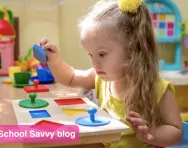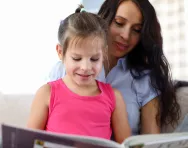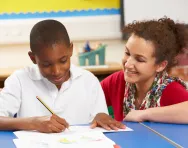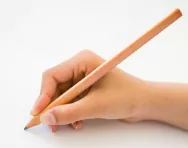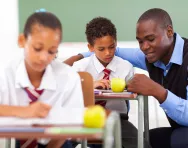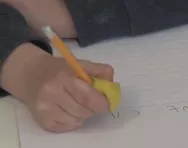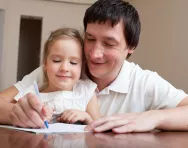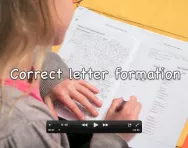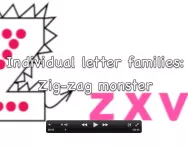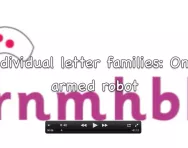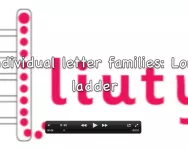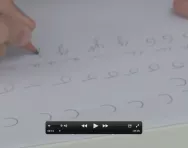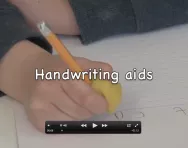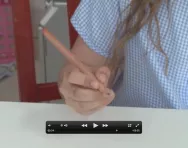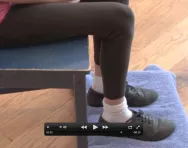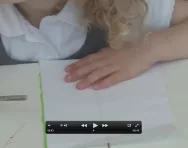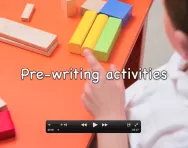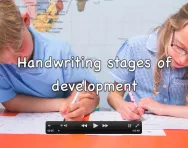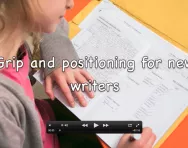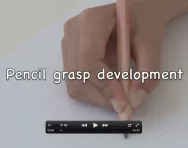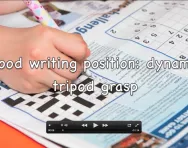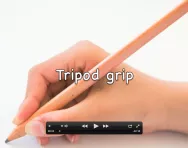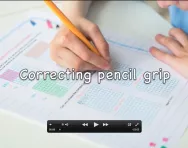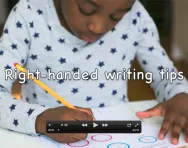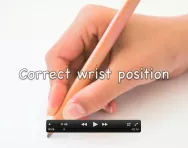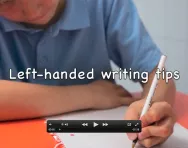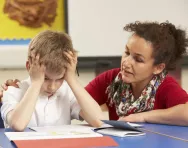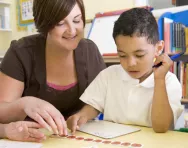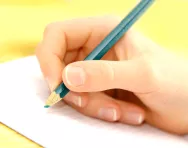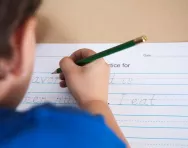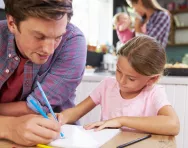SEND funding crisis: Are children at risk?
SEND funding for schools is in a precarious state, leaving the future of education for SEND children uncertain. Primary headteacher Matt Revill shares his perspective on the alarming state of SEND education and offers actionable advice for parents looking to drive change.
Best literacy resources
Whether your child is just learning to read and print letters or looking for ways to put their creative writing skills to the test, we've rounded up some fantastic resources to help them practise phonics, grammar, story-writing and comic-creating at home. Plus there are loads of different ways to connect with authors and listen to stories.
The Welsh ALN Act explained
From September 2020, new provision for special educational needs will come into force in Wales. We explain the new ALN Act.
Handwriting in the National Curriculum
Handwriting may seem an outdated skill, but it’s still important in the primary school classroom. We take a look at what’s expected of our children.
What is a special school?
If your child has special educational needs, a mainstream education may not be right for them. We take a look at how special schools could help.
What is a pen licence?
Earning a pen licence is a proud moment for many primary-school children, but what does your child need to do to achieve this milestone?
Handwriting aids: pencil grips
Does your child struggle to hold their pencil correctly? Handwriting tutor Michelle van Rooyen explains how a pencil grip could help with their handwriting.
Handwriting aids: pens and pencils
With a return to greater emphasis on handwriting in primary schools, could a special pen or pencil help your child master the art of neat writing? Handwriting tutor Michelle van Rooyen explains what handwriting pencils and pens are available.
Video: Correct letter formation
Your child will be taught how to form the different letters of the alphabet differently, according to the ‘movement groups’ they fit into. Our explanatory video shows you how to form all letters (Long ladder, Curly caterpillar, One-armed robot and Z for Zig-zag monster) correctly, stroke by stroke.
Video: Letter formation, Zig-zag monster letter family
Help your child form each letter of the alphabet correctly with our step-by-step and stroke-by-stroke videos, with experts from the National Handwriting Association. In this video we look at the Zig-zag monster letter family: z, x, v, w, y and k.
Video: Letter formation, One-armed robot letter family
Help your child form each letter of the alphabet correctly with our step-by-step and stroke-by-stroke videos, with experts from the National Handwriting Association. In this video we look at the One-armed robot letter family: r, n, m, h, b, k and p.
Video: Letter formation, Curly caterpillar letter family
Help your child form each letter of the alphabet correctly with our step-by-step and stroke-by-stroke videos, with experts from the National Handwriting Association. Here we look at the Curly caterpillar family: c, a, d, g, q, o, e, s and f.
Video: Letter formation, Long ladder letter family
Help your child form each letter of the alphabet correctly with our stroke-by-stroke videos, with experts from the National Handwriting Association. In this video we look at the Long ladder letter family: l, i, u, t and y.
Video: Handwriting letter families
The letters of the alphabet can be divided into ‘movement groups’, based on the movement made to start writing the letter. Each group has a lead letter (L for Long ladder letters, C for Curly caterpillar letters, R for One-armed robot letters and Z for Zig-zag monster letters) and our handwriting advice video outlines the different letter families and how to practise writing them.
Video: Handwriting aids for children
Could a writing slope or an adaptive grip help improve your child's handwriting? Occupational Paediatric Therapist Catherine Elsey explains how to use commercially available handwriting aids in our handwriting advice video.
Video: Tripod grasp quick trick
Make sure your child holds their pencil correctly every time they pick it up with this quick trick, as outlined in our video by National Handwriting Association Occupational Paediatric Therapist Catherine Elsey.
Video: Handwriting posture and seating advice
A step-by-step video guide to establishing a good seating position for comfortable handwriting, with expert advice from the National Handwriting Association and an explanation of why postural stability is vital for children.
Video: Pre-writing activities using scissors
Invest in a pair of child-safe scissors and try some of our pre-handwriting activities, as recommended by the National Handwriting Association experts in our video for parents. Who knew cutting and sticking fun could be so educational?
Video: Pre-writing activities to support handwriting
Support your child's pre-handwriting development in nursery and Reception with fun activities and play, all designed to help build essential motor skills and hand muscles. Our video features experts from the National Handwriting Association, sharing practical ideas you can try at home.
Video: Handwriting development stages explained for parents
From anti-clockwise circles to letter formation, find out about your child's handwriting journey and how you can support them at home in TheSchoolRun's video, featuring experts from the National handwriting Association.
Video: correct handwriting grip and positioning for new writers
Help your child establish great handwriting habits from Reception and KS1 with our expert advice video for the parents of new writers. From the correct pencil grip to paper positioning and posture, the National Handwriting Association's Catherine Elsey explains what to look out for and how to make immediate improvements to help your child.
Video: Pencil grasp development
From eighteen months to five years, TheSchoolRun's handwriting video explains how children's pencil grasp changes over time, how to establish good handwriting habits early on and what to expect in every stage.
Video: The dynamic tripod grasp explained
Video advice and tips to help establish a good handwriting position, including details of the dynamic tripod grasp (the ideal hand position for writing) and why it's best for children to hold their pencil in this way when they're writing.
Video: The dynamic tripod grasp for better handwriting
Children who hold their pencil or pen in the ideal handwriting position, the dynamic tripod grip, can write comfortably for longer. The National Handwriting Association's Catherine Elsey explains how to help your child establish a confident tripod grip and how it helps avoid hand pain.
Video: Correcting pencil grip
Does your child struggle to hold their pencil correctly? Our handwriting tips video offers expert advice on correcting pencil grip and establishing the ideal dynamic tripod grasp, with tips from the National Handwriting Association.
Video: Right-handed handwriting tips and expert advice
Right-handed handwriting tips and advice from the experts, with practical examples of the best way to position paper correctly and hold the pencil with a tripod grasp. Experts from the National Handwriting Association feature in TheSchoolRun's new handwriting video series.
Video: Correct wrist position for handwriting
TheSchoolRun's new handwriting videos feature experts from the National Handwriting Association offering tips to help parents improve their children's handwriting. This video offers advice to help position the wrist correctly for fluid, comfortable handwriting.
Video: Left-handed handwriting tips and expert advice
Left-handed handwriting tips and advice from the experts, with practical examples of the best way to position paper correctly and how to hold your wrist in the optimal position for writing. TheSchoolRun's new handwriting videos feature experts from the National Handwriting Association.
'He struggled to form his letters correctly and his handwriting was illegible'
Cécile Watson, from Bromley in Kent, describes her experience of the SEN and school system with her son Jean-Pierre, 11, who has dysgraphia, and shares her tips for other parents.
How to work with your child’s SENCO
Having a healthy working relationship with your child’s SENCO can help ensure they get the support they need. Here’s how to ensure you make a good team. By Lucy Dimbylow
How a SENCO could help your child
If your child has a special educational need, the school’s SENCO is likely to play a big part in his day-to-day life and learning. Lucy Dimbylow highlights nine ways in which she can help make your child’s school journey easier.
Education, health and care plans (EHCP): expert tips to help parents
SEND experts Antonia Chitty and Tania Tirraoro explain how EHCPs work and share their tips on the application process.
All about dysgraphia
Could your child’s difficulty with writing be dysgraphia? Find out what the signs are, and what to do about it.
Writing practice: how to help your struggling child
Is your child’s handwriting a cause for concern? Help them to improve it with these simple activities.
Settling a child with SEN back into school
After the school holidays any child can find it unsettling heading back to school but it can be especially worrying for children with SEN. Here’s what you can do to help.
Does your child have special educational needs?
Find out about the wide spectrum of special educational needs children can have – and how you can support them at home and get the support they need in school.
How educational psychologists can support SEN children
What is an educational psychologist and how might they help your child? We chat to consultant child educational psychologist Laverne Antrobus to find out.
How can a clinical psychologist help your child with SEN?
Clinical psychologist Elizabeth Kilbey chats to TheSchoolRun about what her job involves and how a clinical psychologist can support a child with special educational needs.
Explaining special needs to children
Amy Schofield speaks to SEN expert Vicki Dawson to find out how to approach the subject with your child.
Making sense of the SEN Code of Practice
Your guide to some of the key procedures and recommended actions in the SEN Code of Practice. Plus find tips on supporting your child.
